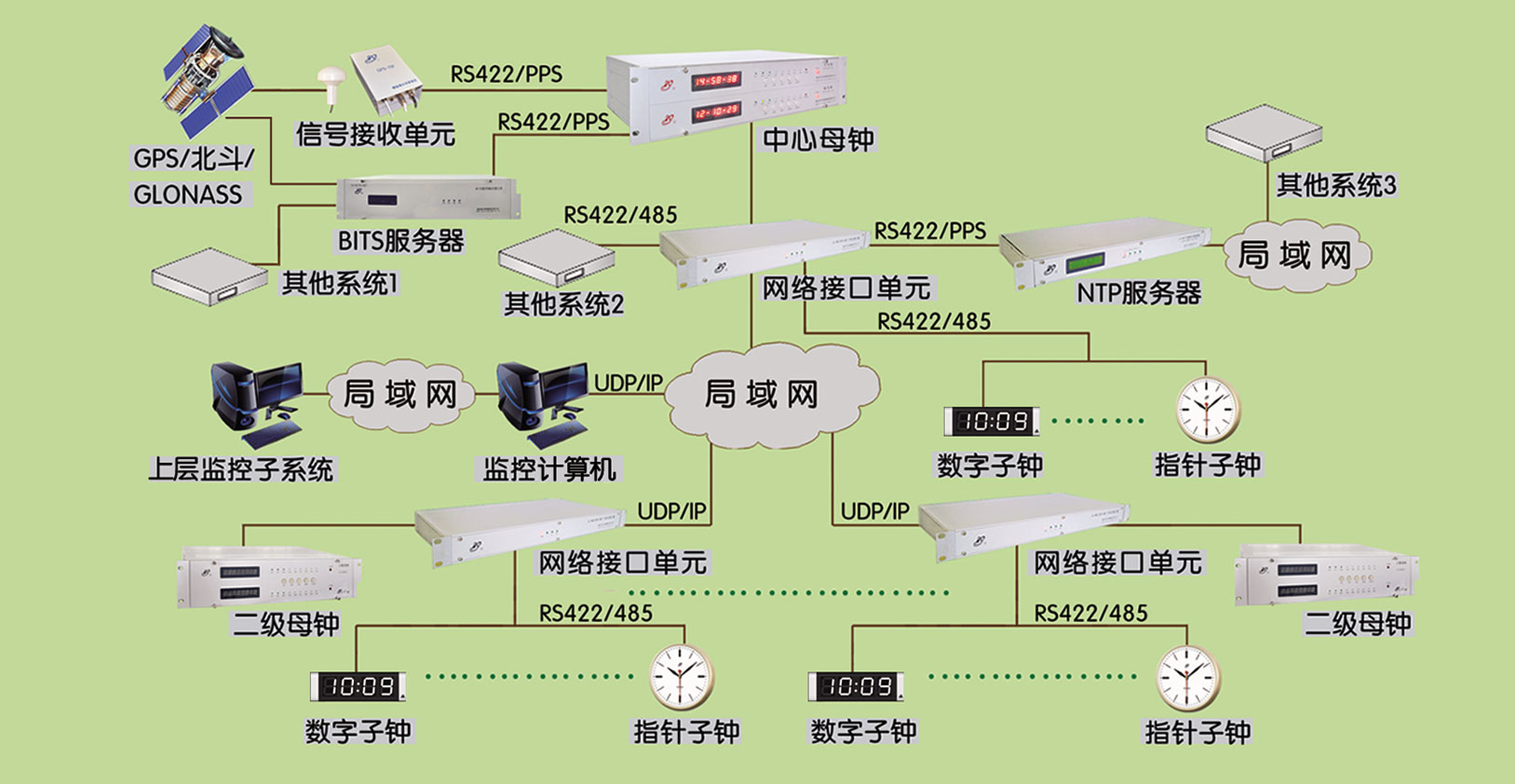Power System Solutions

Basic Features
The central master clock receives the standard time signal from GPS/Beidou/GLONASS, transmits it to each secondary master clock and slave clock through the network interface unit, and provides it to other users by the NTP server, BITS server and network interface unit to realize the time of the whole system Synchronize. At the same time, the state monitoring of the whole system is realized through the monitoring and control computer, and the state information can be provided to the upper-level monitoring system.
Key Features
In order to adapt to the rapid development of communication technology in the network era, the system adopts today's advanced network time synchronization technology, through innovative network time synchronization, network load balancing, adaptive compensation, time reference denoising, clock synchronization security, redundancy backup, network online real-time The key technologies such as monitoring, network fault diagnosis and automatic alarm have realized the high accuracy, high reliability and security of large area network time synchronization. At the same time, the appearance design of the equipment and the decoration style of the site are coordinated with each other to achieve the perfect combination of function and appearance.
Technical parameters
The system adopts a three-layer structure of a central master clock, a secondary master clock, and a slave clock, as well as Ethernet communication. Through the original time filtering, network time closed-loop feedback and other core technology groups, it solves the problems of accuracy, reliability and security of large-area network clock synchronization system, making the clock synchronization technology leading the international level. The system is mainly used for clock synchronization in large areas, such as large-scale comprehensive projects such as rail transit, high-speed railways, hub airports, and nuclear power plants.
System Parameters
| 1) System Architecture: | Three layers |
2) Communication protocol: | NTP protocol, dedicated RS422/RS485 and 2MHz/2Mbit |
3) Communication distance: | equivalent to LAN |
4) Number of secondary master clocks: | ≤1000 one |
5) System standard configuration: | The number of analog sub-clocks and digital sub-clocks can be ≤5000 |
| 6) System synchronization error: | Sub clock≤10ms, NTP server≤2ms, BITS server≤20ns |
Device Parameters
| GPS/Beidou/GLONASS Signal Receiving Unit | |
| 1) Operating temperature: | -30℃~+65℃ |
2) Relative Humidity: | ≤95% |
3) Frequency stability: | 10-12~10-9 |
4) Sync Error: | GPS≤50ns, Beidou≤100ns, GLONASS≤30ns |
5) Signal transmission distance: | ≤1200m |
6) Interface: | Standard RS422/485 |
7) Antenna feeder length: | 5~100m (standard 30m) |
8) Power supply: | AC220V±15% 50Hz±5% |
| 9) Power consumption: | ≤1.4W |
| 10) MTBF: | ≥85,000 hours |
| 11) Antenna: | With dustproof, waterproof, anti-corrosion, lightning protection |
| Central Master Clock | |
| 1) Self-timer precision: | ±0.001s/d |
| 2)Working humidity: | -10℃~+65℃ |
| 3)Relative Humidity: | ≤95% |
| 4) Interface: | Standard RS422/RS485/RS232/NTP |
| 5) Number of standard output ports: | 2 |
| 6) The number of sub-clocks that can be built: | ≤5000 sides |
| 7) Wait for the secondary master clock: | ≤1000 sets |
| 8)Power: | AC220V±15% 50Hz±5% |
| 9) Power consumption: | ≤20W |
| 10) MTBF: | ≥85,000 hours |
Secondary Master Clock | |
1) Self-timer precision: | ±0.01s/d |
2) Working temperature: | -10℃~+65℃ |
3) Relative Humidity: | ≤95% |
4) Interface: | Standard RS422/RS485/RS232/NTP |
5) Number of standard output ports: | 2 |
6) The number of sub-clocks that can be built: | ≤2000 faces |
7) Power: | AC220V±15% 50Hz±5% |
8) Power consumption: | ≤20W |
| 9) MTBF: | ≥85,000 hours |
Analog Clock | |
1) Self-precision: | ±0.05s/d |
2) Output torque: | 800~1200g. cm |
3) Working temperature: | -35℃~+70℃ |
4) Relative Humidity: | ≤95% |
5) Working voltage: | AC220V±15% 50Hz±5% |
| 6) MTBF: | ≥85,000 hours |
Digital Clock | |
| 1) Self-precision: | ±0.05s/d |
| 2) Output torque: | 800~1200g·cm |
| 2) Working temperature: | -35℃~+70℃ |
| 3) Relative Humidity: | ≤95% |
| 4) Working voltage: | AC220V±15% 50Hz±5% |
| 5)MTBF: | ≥85,000 hours |
| 6) Interface: | NTP |
